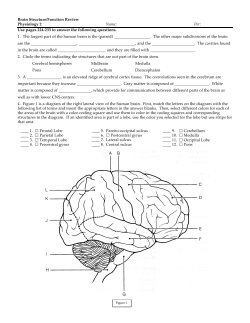
Current concept in intraoperative neuromonitoring
Current concept in intraoperative neuromonitoring Federico Bilotta, MD, PhD University of Rome “Sapienza” 48th National Congress of Turkish Society of Anesthesiology and Reanimation / Ankara - TURKEY • • No conflicts of interest Clinical evidence European Society of Anaesthesiology Berlin May 30-June 2, 2015 Pre Congress Course on Intraoperative Brain Monitoring Join Course of the General Anaesthesia and Neuroanesthesia SubCommitees. Limited to 60 registrants Massimo Lamperti & Federico Bilotta Honorato C Pandin P Avitsian R Absalom A Velly L Pandit J Czosnvka M bilotta@tiscali.it EEG Evoked Potential NIRS Cerebral Oximetry BIS TIVA or volatiles TCD Electrophysiology: Electroencephalogram (EEG), Bispectral Index (BIS), Quantitative EEG (QEEG) Sinking of the hospital ship «Centaur», II-WW The B-Aware trial showed that anesthetic administration guided by bispectral index (BIS) reduces the incidence of intraoperative awareness Observational study in 2662 patients: >/≤ 5 min EEG suppression 90 days post op mortality similar in 2 groups: 6.3% vs. 3.0% (OR2.19, NS); EEG suppression + hypotension (MAP<55mmHg) IS predictive (OR2.93!!) Conclusion: - Low BIS values are associated with increased post op mortality. - EEG is a predictor of increased post op mortality ONLY if coincident with low MAP Multimodal monitoring index compared with BIS alone. 263 patients undergoing General Anesthesia. Multimodal index showed a tighter relation with wake status as compared with BIS alone. Intraoperative spinal cord monitoring, effects of peripheral nerve stimulation on burst suppression (BS) patterns. In 9 patients BS was measured before and after ulnar nerve stimulation. The use of techniques reviewed in these guidelines may reduce perioperative neurological morbidity and mortality Electrophysiology Evoked Potentials Sung-‐Min Kim,1 Seung Hyun Kim,2 Dae-‐Won Seo,3 and Kwang-‐Woo Lee1 Indications: - Cerebral tumor surgery - Brainstem surgery - Spinal surgery - Vascular surgery (CEA) - Thyroid/Parathyroid/Esophagus - Peripheral nerves In 89 patients undergoing MCA aneurysm surgery. Abolish 50% of MEP and SSEP. In 15 patients changes in MEP were independent prognostic for long term motor outcome (31mo). MEP reliably identify ischemic intraoperative complications. Jason S. Cheng, M.D.,1 Michael E. Ivan, M.D.,1 Christopher J. Stapleton, M.D.,1 Alfredo Quinones-‐ Hinojosa, M.D.,2 Nalin Gupta, M.D., Ph.D.,1,3 and KurMs I. Auguste, M.D.1 Retrospective data analysis from 12 patients with intramedullary spinal cord tumor resection. Intraoperative MEP changes in 6, accurately predicted postoperative motor changes. Spinal cord had limited tolerance to SSEP decrease. Near-Infrared Spectrometry (NIRS) Microdialysis In 32 SAH patients undergoing coiling, NIRS and NR monitoring (every 10-15 min). No association with BL rSO2 and side of the aneurysm or WFNS grade. Angiographic spasm was associated with a Trend in ispilateral NIRS reduction In 27 patients undergoing ascending aorta replacement monitored with NIRS cerebral rSO2 and left radial artery antegrade cerebral perfusion (ACP). In 2 patients temporary post op neurological deficits. No permanent Pos top neurological deficits. Conclusions: NIRS-cerebral rSO2 and left radial ACP provide accurate measurment of cerebral perfusion. In 200 patients assigned to INVOS interventional (rSO2> 80%) or control. POCD on post op day 7th: 28% VS. 52% (p<0.002) CONCLUSION: Postoperative cognitive outcome was significantly better in patients with intraoperative cerebral oximetry monitoring. Prolonged rSO2 desaturation is a predictor of cognitive decline and has to be avoided. Observational series of 120 retrospective cases undergone infra inguinal by pass surgery. Monitored with CO, BIS and NIRS. Use of multimodal intraoperative monitoring, aimed to build up of O2 debt should be subject to RCT control Review of 133 articles Neurosurgery Maxillfacial Thoracic Vascular Urology…etc Conclusions: certain non-cardiac surgical procedures are associated with an increased risk of rScO2 (thoracic, major abdominal, laparoscopic, hip). Evidence for an association between cerebral desaturation and postoperative outcome parameters needs to be established. The available evidence for the validity of cerebral microdialysis as a diagnostic tool during brain surgery is of low scientific quality. In order to develop cerebral microdialysis as a valid instrument for monitoring of brain metabolism during surgery, standardized clinical prospective studies in homogeneous patient populations are required Cerebral Blood Flow Transcranial Doppler and color Doppler Conclusions - EEG burst suppression was considered to be “neuroprotective”, now we know that it is associated with increased mortality; - BIS monitoring reduces episodes of awareness; - Extreme BIS values are associated with higher risk of POD; - Peripheral nerve stimulation affects BIS values; - Multimodal monitoring is more accurate than BIS in the evaluation of anesthesia depth, COULD be effective in reducing postoperative deficits. - Evoked potentials provide insights in brain surgery and EFFECTIVELY reduce peripheral deficits after spinal procedures. - Ultrasound (2D & Doppler) provide effective information on CBF Monitoring systems –per se- do not interfere with the clinical course unless appropriate data evaluation and coherent therapeutic/management initiatives are undertaken; Thank you Microdialysis
© Copyright 2025





















